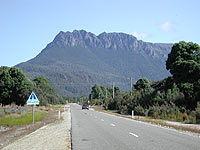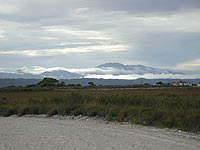

Mt Murchison
Early morning near Strahan
|
Birding trip to Tasmania February 2003 Part Two |
Leaving Cradle Mountain somewhat reluctantly we again set off west, this
time for Strahan, where we arrived around six pm.
Strahan is a tourist town where boat-trips can be taken to the Gordon River
and the historic Macquarie Heads.
Saturday morning was a bit damp, with light-drizzle and so we went along the
coast road to the ocean approximately 4-5kms from Strahan through the
coastal heathland reserve. I spotted some small grass-parrots which I
assumed (at the time) were Blue-winged and proceeded to digiscope them when
I saw what I thought was a House Sparrow due to the poor-light. Imagine my
surprise when I put my bins up and realised that I was looking at a
Beautiful Firetail....one of my most 'sought-after' species! Unfortunately I
failed to digiscope them but I'm still pondering over the identity of the
parrots, could they have been Orange-bellied? (One certainly had an orange
belly, if anyone can help me out I would appreciate it.)
On the ocean thousands of Short-tailed Shearwater gathered but apart from a
few Australasian Gannets no other species were seen.
|
|
|
|
Mt Murchison |
Early morning near Strahan |
After leaving Strahan we passed through the terrible landscape that man has
created around Queenstown with excessive mining and total tree-eradication
from pollution. I don't recall seeing any bird species here.
From Queenstown we drove over the roof of Tasmania through Franklin/Gordon
and Cradle Mountain National Parks and took several short-walks and although
the scenery was spectacular we saw relatively few bird-species apart from a
pair of immature Brown Goshawks calling loudly.
|
|
|
|
Lunch Lookout |
Nelson Falls |
At Lake St Clair birding improved a little and we had our best views of
Black Currawong and Crescent Honeyeater but we failed to see Flame Robin
which was described on the parks bird-list as "Very Common". Unfortunately
we failed to catch up with this species throughout the trip despite seeing
many Scarlet Robins virtually every day.
|
|
|
|
Tasmanian Pademelon |
Echidna |
Saturday ended at Mt Field National Park where we did some spot-lighting,
here we saw Tasmanian Pademelon, Common Ringtail and Common Brushtail, the
coloration of the latter two species was a surprise, some Brushtails being
similar to ours in SE Qld although the majority were almost black. The
ringtail was very different, grey/black and white against our
coppery-coloured ones. The Pademelons were very abundant here and roadkills
littered nearby roads. Between Strahan and Mt Field we saw several
Echidna and rescued a couple from a similar fate.
|
|
|
|
Russell Falls |
Tree Fern |
Mt Field was one of Australia's first
National Parks and Russell Falls has been a very popular attraction since
the last century.
We spent the night at the quaint National Park Hotel, a stone's throw from
the entrance and very good value.
|
|
|
|
National Park Hotel |
Beer & 'endemics' |
On Sunday we made our way to Hobart and on to Kettering to get to Bruny
Island, fortunately just catching the last morning
ferry. Soon after arriving we passed a large eucalypt and saw a male Satin
Flycatcher with young and a
Dusky Robin.
Driving on to South Bruny we found some cabins at Captain Cook Memorial
Caravan Park and checked in. This was an excellent birding site with a
nearby swamp and we saw at least six
Brush Bronzewings here in the morning,
feeding with
Green Rosella. Across the road
Pacific Gulls wandered the beach
after crabs, though I didn't see the Hooded Plover and Fairy Terns that were
supposed to breed there too.
Checking the proposed flight to Melaleuca on Monday it transpired that the
pilot was coming to Bruny to pick up another birder who was staying on the
island and they agreed that we could board the flight at the airstrip too,
although the weather forecast was anything but promising, a front with
high-winds and gales expected.
Later in the afternoon whilst birding from Cloudy Bay we met the other
birder, Peter from Tenterfield and made arrangements to meet him on the
following morning at the airstrip. At Cloudy Bay the weather was very windy
from the south-west and I managed to get some nice shots of a
Sooty
Oystercatcher.
Before dusk at we drove up to the 'Neck' (the Causeway between North and
South Bruny Islands) and with several other cold, wet souls witnessed Fairy
Penguins and hundreds of Short-tailed Shearwaters returning to their
burrows.
|
|
|
|
Cloudy Bay Scenery |
Cloudy Bay Scenery |
The front arrived in the evening and we assumed that the flight would
probably not go ahead, and rain lashed the cabin throughout the night. In
the morning I realised that my mobile phone was out of range so I went to
the telephone kiosk near the general store and rang the Par-Avion office at
Cambridge Airport, I was amazed when Holly, the receptionist exclaimed that
she had heard that the weather was fine in Melaleuca and the flight was to
go ahead as planned!
|
|
|
|
boarding the flight! |
Bruny Island Neck |
We met Peter birding close to the airstrip and our light aircraft appeared
over the horizon and picked us up. Matt the pilot gave us a ride to remember
taking us over landscape with very few signs of human disturbance and
spectacular scenery. Though I remember thinking that Holly's weather
prognosis was a bit optimistic as we passed through large shower clouds and
sleet. After about 40 minutes we touched down at the airstrip and walked
about a hundred metres to the bird-hide.
|
|
|
|
South-west scenery |
South-west scenery |
Once inside I was amazed to see
Beautiful Firetails on the feeder although ominously there were no signs of
our objective, the
Orange-bellied Parrot. As most of the other visitors took
a side-trip on a boat we were left in the hide, with a box of biscuits and a
coffee.....and fingers-crossed. An age went by with a couple of
Green
Rosellas, Tree Martins and Yellow-throated Honeyeater appearing at the
feeder, but no OBP. When the boat-people returned I was sure that this was
going to be a very expensive 'dip' and then as if out of nowhere, a male
arrived in front of us.
Fortunately I managed to come out of my 'awe-struck' state and got a few
digiscoped shots, although I missed the best one when he perched on a twig
showing us all his splendour.....oh well, next time.
|
|
|
|
Aerial view of Melaleuca (hide is right of centre of image) |
View from Melaleuca airfield |
On our last morning in Tasmania, we had some spare time before the 10am
ferry so we decided to try and obtain better views of Forty-spotted
Pardalote at a well-known area on North Bruny near Dennes Point. We followed
the instructions to drive to about 3.5 kms south of the point and look in
the Manna Gums (Eucalyptus viminalis) which is the birds preferred habitat.
Fortunately the wind had dropped and we had excellent view of at least 3
calling birds. So ended an excellent weeks birding.
If anyone would like more detailed
information regarding locations and birds mentioned in this report please
contact us.
|
|
|
|